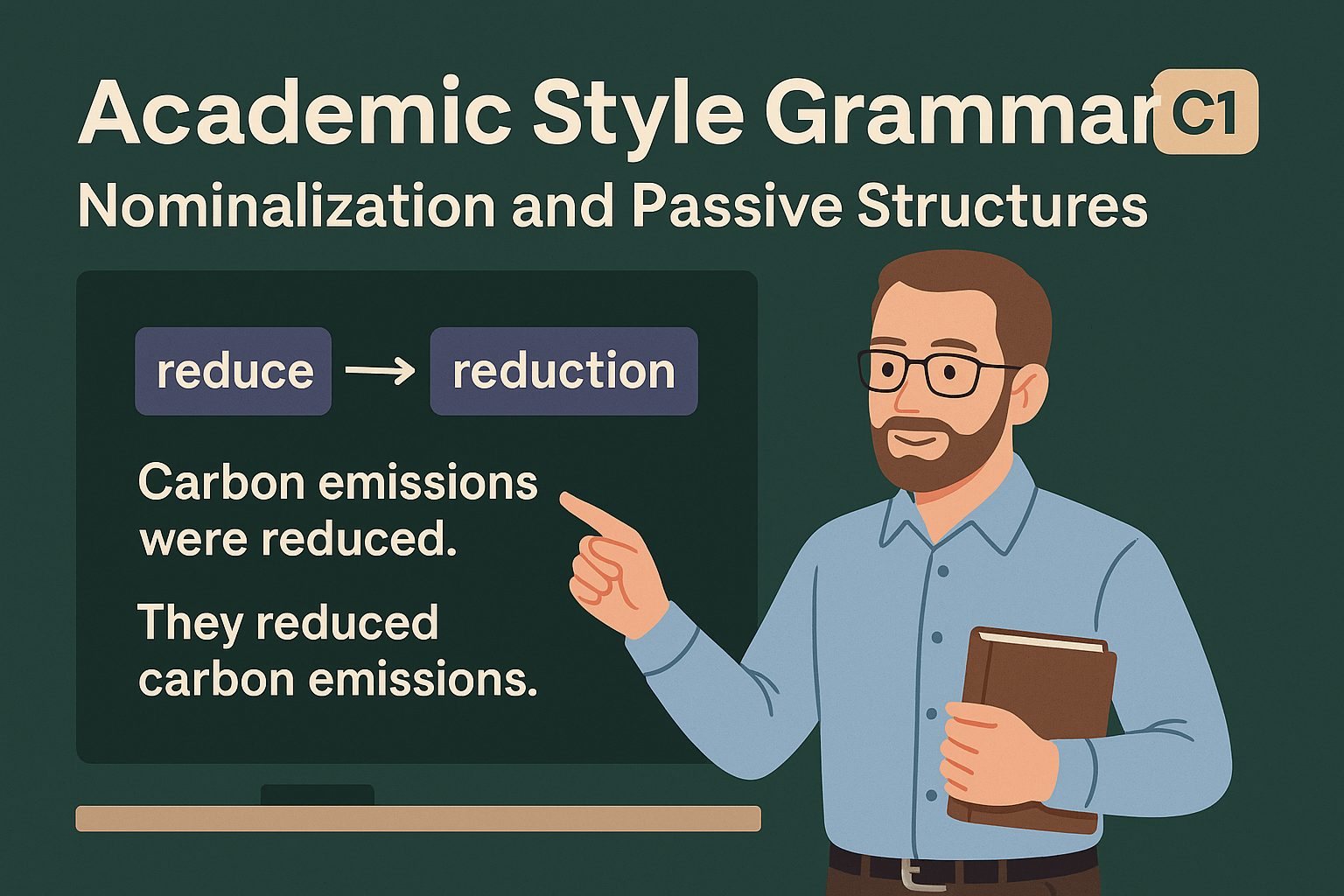В предыдущем уроке мы изучили общую структуру и язык академических исследований. Теперь мы углубимся в специфические грамматические особенности, которые отличают академический стиль от повседневной речи. Понимание номинализации и продвинутых пассивных конструкций — ключ к созданию профессиональных научных текстов на английском языке.
🎯 Цели урока
После изучения этого урока вы сможете:
- Использовать номинализацию для создания более формального и краткого стиля
- Применять различные типы пассивных конструкций в академическом контексте
- Трансформировать простые предложения в сложные академические структуры
- Распознавать и анализировать грамматические особенности научных текстов
📚 Основные концепции
Номинализация: превращение действий в понятия
Номинализация — это процесс превращения глаголов и прилагательных в существительные. Это один из важнейших инструментов академического стиля, который позволяет:
- Сделать текст более плотным и информативно насыщенным
- Создать более объективный и научный тон
- Упростить сложные идеи для последующего анализа
🔍 Типы номинализации
1. Глагольная номинализация
Превращение глаголов в существительные:
| Глагол | Номинализация | Пример |
|---|---|---|
| analyze | analysis | The analysis revealed significant patterns |
| develop | development | The development of new technologies |
| conclude | conclusion | Our conclusion supports the hypothesis |
| implement | implementation | The implementation of the policy |
| investigate | investigation | This investigation focuses on... |
Сравнение стилей:
Обычный стиль: "We analyzed the data and found that productivity increased significantly."
Академический стиль: "Data analysis revealed significant productivity increases."
2. Прилагательная номинализация
Превращение прилагательных в существительные:
| Прилагательное | Номинализация | Пример |
|---|---|---|
| accurate | accuracy | The accuracy of measurements is crucial |
| efficient | efficiency | Energy efficiency improvements |
| significant | significance | The significance of these findings |
| complex | complexity | The complexity of the problem |
| relevant | relevance | The relevance to modern society |
🔍 Продвинутые пассивные конструкции
1. Классический пассив в академическом контексте
Основная функция: Смещение фокуса с агента действия на само действие или его результат.
Активный залог: "Researchers conducted the experiment in controlled conditions." Пассивный залог: "The experiment was conducted under controlled conditions."
2. Безагентный пассив
Наиболее распространенная форма в академическом письме, где агент действия не указывается:
- "Significant correlations were observed between variables."
- "The methodology was designed to minimize bias."
- "Results were analyzed using statistical software."
3. Пассив с формальными подлежащими
It + пассивная конструкция:
- "It has been established that..."
- "It should be noted that..."
- "It can be argued that..."
There + пассивная конструкция:
- "There have been conducted numerous studies..."
- "There are believed to be several factors..."
4. Пассив с глаголом "get" в академическом контексте
Хотя пассивные конструкции с глаголом "get" обычно неформальны, в некоторых академических контекстах они приемлемы:
- "The data got corrupted during transmission" (технические тексты)
- "Results get published in peer-reviewed journals"
⚠️ Правила и особенности американского академического стиля
Номинализация: ключевые принципы
-
Модерация — ключ к успеху
- Не номинализируйте каждый глагол
- Сохраняйте баланс между ясностью и формальностью
-
Предпочтительные суффиксы в американском английском:
- -tion/-sion: investigation, discussion
- -ment: development, assessment
- -ity/-ty: complexity, reliability
- -ness: effectiveness, awareness
- -ance/-ence: significance, relevance
-
Номинализация с предлогами:
- "The implementation of the policy" (не "The policy implementation")
- "Analysis of the data" (не "Data analysis" в формальном контексте)
Пассивные конструкции: американские особенности
-
Частотность использования:
- Научные статьи: 30-40% пассивных конструкций
- Гуманитарные тексты: 20-30%
- Технические документы: до 50%
-
Избегание первого лица:
- Вместо "I believe" → "It is believed"
- Вместо "We found" → "It was found"
-
Модальность в пассиве:
- "The results can be interpreted as..."
- "The hypothesis should be tested further"
- "The methodology must be refined"
🧠 Мнемотехники для запоминания
Мнемоника ANTS для номинализации
Action → Noun Transformation Strategy
A - Analyze (проанализируй глагол) N - Name (найди существительное) T - Test (проверь в контексте) S - Strengthen (усиль академичность)
Мнемоника PASS для пассивных конструкций
Purpose - зачем нужен пассив? Agent - нужно ли указывать агента? Style - подходит ли по стилю? Sentence - как вписывается в предложение?
Визуальная ассоциация: "Академический айсберг"
Представьте айсберг:
- Вершина (видимая часть) = простые конструкции
- Подводная часть = номинализация и пассив
- Чем больше подводная часть, тем более академичен текст
⚠️ Типичные ошибки русскоговорящих
1. Чрезмерная номинализация
Ошибка: "The investigation of the analysis of the implementation of the policy showed effectiveness."
Правильно: "Policy implementation analysis revealed effectiveness."
2. Неправильный порядок слов с номинализацией
Ошибка: "The policy implementation" (калька с русского)
Правильно: "The implementation of the policy" (в формальном контексте)
3. Избыточное использование пассива
Ошибка: "The experiment was conducted and results were obtained and analysis was performed."
Правильно: "The experiment was conducted, yielding results that underwent analysis."
4. Неуместные конструкции с глаголом "get"
Ошибка: "The hypothesis got proven by researchers."
Правильно: "The hypothesis was proven by researchers."
5. Неправильная номинализация русских глаголов
Ошибка: "realizement" вместо "realization"
Правильно: Изучите устоявшиеся формы номинализации
👥 Практические диалоги
Диалог 1: Научная конференция
Dr. Sarah Chen: The implementation of our new methodology has yielded remarkable results.
Prof. Michael Rodriguez: Could you elaborate on the effectiveness of this implementation?
Dr. Chen: Certainly. Data analysis revealed a 40% improvement in accuracy. The significance of these findings cannot be overstated.
Prof. Rodriguez: Has peer review been conducted on this research?
Dr. Chen: Yes, the paper was submitted for review last month. The evaluation process is currently underway.
Диалог 2: Защита диссертации
Committee Chair: Please explain the theoretical foundation of your research.
PhD Candidate: The development of this framework was guided by three key principles. First, the integration of existing theories was prioritized. Second, empirical validation was conducted through extensive fieldwork.
Committee Member: How was bias minimized in your methodology?
Candidate: Several measures were implemented. Randomization was employed in sample selection, and double-blind procedures were utilized during data collection.
Диалог 3: Рецензирование статьи
Editor: The manuscript requires significant revision before publication can be considered.
Author: What specific improvements are needed?
Editor: The argumentation needs strengthening. Additionally, the conclusion should be supported by more robust evidence. Statistical analysis must be expanded to include correlation coefficients.
Author: I understand. Will the revision process involve additional peer review?
Editor: Yes, revised manuscripts are subjected to re-evaluation by the original reviewers.
📊 Итоговая схема: Академическая грамматическая трансформация
| Элемент | Обычный стиль | Академический стиль | Функция |
|---|---|---|---|
| Действие | We studied | The study examined | Объективность |
| Результат | We found that | Findings indicate that | Формальность |
| Мнение | I think | It can be argued that | Дистанцирование |
| Процесс | When we tested | During testing | Номинализация |
| Причина | Because X happened | Due to the occurrence of X | Сложность |
Алгоритм академической трансформации:
- Identify (определите основное действие)
- Nominalize (превратите в существительное, если уместно)
- Passivize (используйте пассив для объективности)
- Formalize (добавьте академические маркеры)
- Integrate (вплетите в контекст)
📝 Упражнения
Упражнение 1: Трансформация в номинализацию (Базовый уровень)
Превратите следующие предложения, используя номинализацию:
- Researchers developed a new method. They found that it worked better than the old one.
- The company implemented new policies. This resulted in higher productivity.
- Scientists analyzed the data carefully. They concluded that the hypothesis was correct.
- The team investigated the problem thoroughly. They discovered several important factors.
- Experts evaluated the program. They determined that it was effective.
Упражнение 2: Пассивные конструкции (Средний уровень)
Преобразуйте активные конструкции в пассивные, сохраняя академический стиль:
- The research team conducted three separate experiments to validate the hypothesis.
- Specialists designed the questionnaire to minimize response bias.
- We collected data from 500 participants over a six-month period.
- The authors based their conclusions on extensive statistical analysis.
- Peer reviewers evaluated the manuscript according to strict criteria.
Упражнение 3: Комплексная трансформация (Продвинутый уровень)
Превратите следующий неформальный текст в академический, используя номинализацию и пассивные конструкции:
"I decided to study how social media affects teenagers' self-esteem. I thought this was important because lots of people are worried about it. I asked 200 teenagers to fill out questionnaires and interviewed 20 of them. I found that teenagers who use social media more often have lower self-esteem. I think schools should teach kids about the dangers of social media."
📝 Домашнее задание
Задание 1: Анализ академического текста
Найдите в интернете аннотацию (abstract) научной статьи на английском языке. Выделите:
- 5 примеров номинализации
- 3 примера пассивных конструкций
- 2 примера формальных подлежащих (it/there constructions)
Задание 2: Создание академических предложений
Используя данные слова, создайте академические предложения с номинализацией:
- investigate, reveal, significant
- implement, result, improvement
- analyze, demonstrate, correlation
- evaluate, indicate, effectiveness
- examine, suggest, relationship
Задание 3: Трансформация диалога
Превратите следующий диалог между коллегами в формальное академическое изложение:
A: "We tested the new drug on mice and it worked really well." B: "How well exactly?" A: "The mice got better much faster than with the old treatment." B: "Did you check if there were any side effects?" A: "Yes, we didn't find any problems."
Задание 4: Написание мини-аннотации
Напишите аннотацию (100-120 слов) для воображаемого исследования на тему "Влияние удаленной работы на продуктивность сотрудников". Используйте:
- Минимум 3 номинализации
- Минимум 2 пассивные конструкции
- Академический стиль изложения
Задание 5: Самоанализ
Проанализируйте свой собственный стиль письма на английском. Напишите короткий параграф (80-100 слов) о том, какие академические структуры вам даются легко, а какие требуют дополнительной практики.
✅ Ответы к упражнениям
Ответы к упражнению 1:
- The development of a new method by researchers resulted in improved performance compared to the previous approach.
- The implementation of new policies resulted in productivity enhancement.
- Careful data analysis led to confirmation of the hypothesis.
- Thorough investigation of the problem resulted in the discovery of several important factors.
- Program evaluation by experts demonstrated its effectiveness.
Ответы к упражнению 2:
- Three separate experiments were conducted by the research team to validate the hypothesis.
- The questionnaire was designed by specialists to minimize response bias.
- Data were collected from 500 participants over a six-month period.
- Conclusions were based on extensive statistical analysis.
- The manuscript was evaluated by peer reviewers according to strict criteria.
Ответы к упражнению 3:
Возможный вариант академической трансформации:
"The decision to investigate social media's impact on adolescent self-esteem was motivated by widespread concern regarding this phenomenon. The importance of this research area has been recognized due to growing public anxiety about social media effects. Data collection was conducted through questionnaire administration to 200 adolescents and interviews with 20 participants. Analysis revealed a negative correlation between social media usage frequency and self-esteem levels among teenagers. The findings suggest that educational intervention regarding social media risks should be implemented in school curricula."
Примеры ответов к домашнему заданию 2:
- Investigation revealed significant correlations between the studied variables.
- Policy implementation resulted in measurable performance improvement.
- Statistical analysis demonstrated strong correlation between factors.
- Program evaluation indicated considerable effectiveness in target areas.
- Examination of the data suggested meaningful relationships between variables.


